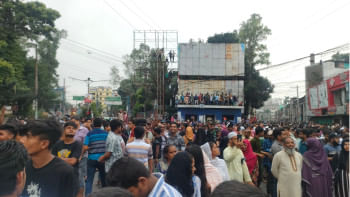Bangladesh’s share in global RMG trade trebles in 17 years

Bangladesh's share in the global readymade garment trade more than tripled in the past 17 years as the country cements its position as one of the largest suppliers internationally.
In 2005, the country's share was 2.5 percent but it rocketed to 7.9 percent last year, data from the World Trade Statistical Review 2023 showed.
In 2000, Bangladesh shipped garment items worth $4.82 billion. It posted a meteoric rise in the past 22 years, elevating earnings to $45 billion last year.
A number of factors have driven the expansion in the past two decades as the country solidified its place as the second-largest apparel supplier in the world after China and raised its market share.
One of the strengths has been the expanding primary textile sector, which has already invested more than $23 billion.
As a result, the knitwear segment currently can avail more than 90 percent of fabrics and yarn from domestic markets, which have cut the lead time by four weeks.
Similarly, woven exporters can procure more than 40 percent of fabrics locally. Equally, the accessories sector meets 90 percent of the demand.
The China-US trade tension has worked in Bangladesh's favour.
For example, China's share in the global apparel busines was 18.2 percent in 2000, 26.6 percent in 2005, and 36.6 percent in 2010. But it declined to 31.7 percent in 2022, owing largely to the rift that began in 2018.
So, while Bangladesh's share has continued to widen, China is losing its grip.
What is even more extraordinary for Bangladesh is that it has been capturing more market share despite the shortage of raw materials such as cotton and capital machinery and recurrent challenges such as energy.
Still, Bangladesh is also the largest apparel supplier to the European Union in terms of volume and the largest denim supplier worldwide.
Faruque Hassan, president of the Bangladesh Garment Manufacturers and Exporters Association, said exporters are also getting better prices.
He said exporters are receiving 10 percent to 30 percent higher prices per unit garment item. In the case of high-end value-added items, the price has gone up by a similar rate.
Md Fazlul Hoque, managing director of Plummy Fashions Ltd, thinks apart from the trade war and the backward linkage integration, Bangladesh has developed a lot of skilled workforce and skilled managers, improved productivity, ensured faster delivery of goods, enhanced quality, and introduced green initiatives.
The garment sector as defied major domestic and global crises such as the elimination of the quota system, the financial crisis of 2007-08, the Tazreen Fashions fire, the Rana Plaza building collapse and political crisis.
"It has been possible because of the commitment of entrepreneurs," he said.
Bangladesh's reputation as a predictable supplier received a major boost during the peak of the coronavirus pandemic as the country kept factories open for most of the time whereas many competitors had kept their industries closed for a longer period.
Anwar ul Alam Chowdhury Parvez, a former president of the BGMEA, said the growth of global population over the last 20 years also helped lift Bangladesh's export receipts.
"Similarly, a higher cost of raw materials brought better prices."
FUTURE LOOKS EVEN BRIGHTER
Exporters are gearing up to grab more market share on the bank of diversified products and markets. They are putting more money in new projects, marketing, fashion, and design.
Bangladesh is expected to raise its market share to 10 percent by 2025 as the shipment is on the rise despite the disruptions caused by post-Covid-19 challenges and the ongoing Russia-Ukraine war.
Local exporters are betting on Asian markets such as Japan, India, South Korea and Australia where exports are rising phenomenally and there is more room to grow.
With the trade row in place, not only American buyers but also European and Japan retailers and brands have started reducing sourcing from China.
Bangladesh has also started producing high-end garment items like a jacket worth $100 apiece. This was almost impossible a few years ago.
Although Bangladesh will have to go a long way before outracing China in the global apparel trade, local exporters have overtaken their competitors in the second-biggest economy in the world and are set to repeat the same success in other markets as well.
Last year, Bangladesh's garment export to the US surged 53 percent to nearly $10 billion.
However, in the January-April period of 2023, the shipment to the US declined by nearly 17 percent against China's more than 30 percent owing to the impacts of higher consumer prices. This indicates that Bangladesh's sales in the world's largest economy will grow despite facing a 15.62 percent duty.
The BGMEA has set a target to generate export earnings worth $100 billion and lift market share to 14 percent by 2030 on the back of the growth in Asian markets and the increasing use of man-made fibre-based garment items, which fetch almost double prices compared to cotton-made products.
Kutubuddin Ahmed, chairman of Envoy Legacy, said the cotton price has played a major role for the higher export growth from Bangladesh.
Mohammad Hatem, executive president of the Bangladesh Knitwear Manufacturers and Exporters Association, said green initiative is one of the major reasons for the spike in shipment growth.
Bangladesh is already a champion when it comes to eco-friendly apparel manufacturing units and has the highest number of green factories certified by the United States Green Building Council.
Mohammad Ali Khokon, president of Bangladesh Textile Mills Association, thinks exporters have the capacity to capture a 10 percent market share but it is standing at 7 percent because of gas and power crises.

 For all latest news, follow The Daily Star's Google News channel.
For all latest news, follow The Daily Star's Google News channel. 



Comments